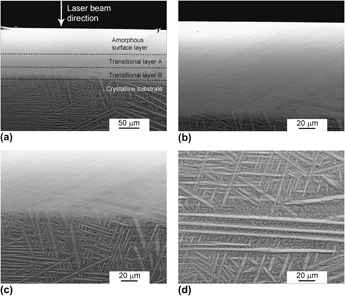Crossref Citations
This article has been cited by the following publications. This list is generated based on data provided by
Crossref.
Yang, Qin
Li, Ran
Liu, ZengQian
Shi, MinJie
Luo, XueKun
and
Zhang, Tao
2012.
Compositional dependence of microstructure and tribological properties of plasma sprayed Fe-based metallic glass coatings.
Science China Technological Sciences,
Vol. 55,
Issue. 5,
p.
1335.
Zhang, Huiyan
Li, Ran
Ji, Yunfei
Liu, Fanmao
Luo, Qiang
and
Zhang, Tao
2012.
Glass formation, magnetic properties and magnetocaloric effect of ternary Ho–Al–Co bulk metallic glass.
Journal of Magnetism and Magnetic Materials,
Vol. 324,
Issue. 23,
p.
4064.
Wu, Guojuan
Li, Ran
Liu, Zengqian
Chen, Bingqing
Li, Yan
Cai, Yan
and
Zhang, Tao
2012.
Induced multiple heterogeneities and related plastic improvement by laser surface treatment in CuZr-based bulk metallic glass.
Intermetallics,
Vol. 24,
Issue. ,
p.
50.
Welk, Brian A.
Fraser, Hamish L.
Dixit, Vikas
Williams, Tim
and
Gibson, Mark A.
2014.
Phase Selection in a Laser Surface Melted Zr-Cu-Ni-Al-Nb Alloy.
Metallurgical and Materials Transactions B,
Vol. 45,
Issue. 2,
p.
547.
Xu, Tao
Pang, Shujie
Li, Haifei
and
Zhang, Tao
2015.
Corrosion resistant Cr-based bulk metallic glasses with high strength and hardness.
Journal of Non-Crystalline Solids,
Vol. 410,
Issue. ,
p.
20.
Zhu, Yunhu
Fu, Jie
Zheng, Chao
and
Ji, Zhong
2015.
Effect of laser shock peening without absorbent coating on the mechanical properties of Zr-based bulk metallic glass.
Optics & Laser Technology,
Vol. 75,
Issue. ,
p.
157.
Xu, Tao
Pang, Shujie
and
Zhang, Tao
2015.
Glass formation, corrosion behavior, and mechanical properties of novel Cr-rich Cr–Fe–Mo–C–B–Y bulk metallic glasses.
Journal of Alloys and Compounds,
Vol. 625,
Issue. ,
p.
318.
Guo, L.Y.
Geng, S.N.
Pang, J.
Hu, Y.H.
Lan, S.
Wang, C.M.
and
Wang, W.M.
2018.
Structural transformation and property improvement of Fe78Si9B13 amorphous ribbon by pulsed laser processing.
Materials & Design,
Vol. 160,
Issue. ,
p.
538.
Hasani, S.
Rezaei-Shahreza, P.
Seifoddini, A.
and
Hakimi, M.
2018.
Enhanced glass forming ability, mechanical, and magnetic properties of Fe 41 Co 7 Cr 15 Mo 14 Y 2 C 15 B 6 bulk metallic glass with minor addition of Cu.
Journal of Non-Crystalline Solids,
Vol. 497,
Issue. ,
p.
40.
Guo, Lingyu
Geng, Shaoning
Gao, Xuesong
and
Wang, Weimin
2021.
Numerical simulation of heat transfer and fluid flow during nanosecond pulsed laser processing of Fe78Si9B13 amorphous alloys.
International Journal of Heat and Mass Transfer,
Vol. 170,
Issue. ,
p.
121003.
Ma, Huwen
Zhao, Yanchun
Wang, Xue
Ma, Dong
and
Gao, Yanfei
2022.
Synergistic effects of microstructural inhomogeneity and phase-transformation-induced plasticity for ductility improvements in metallic glass composites.
Materials Science and Engineering: A,
Vol. 849,
Issue. ,
p.
143491.
Hua, Nengbin
Geng, Dehu
Ye, Youxiong
Liao, Zhenlong
Wang, Qianting
Dai, Pinqiang
Fang, Hui
Zhang, Lei
and
Liaw, Peter K.
2023.
Self-lubricating behavior of a PdCuNiP glassy alloy by in-situ nanocrystallization during dry friction.
Journal of Non-Crystalline Solids,
Vol. 616,
Issue. ,
p.
122485.
Xie, Chaoju
Xu, Ning
Zhang, Meng
Zhou, Shengfeng
Lin, Huaijun
Li, Zu
and
Li, Wei
2024.
Tribological behaviors of Zr-based bulk metallic glass against Si3N4 ceramic under linear reciprocating sliding.
Journal of Non-Crystalline Solids,
Vol. 646,
Issue. ,
p.
123266.
